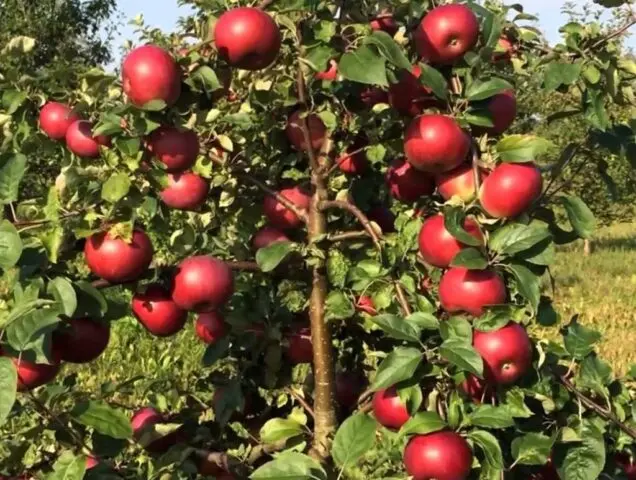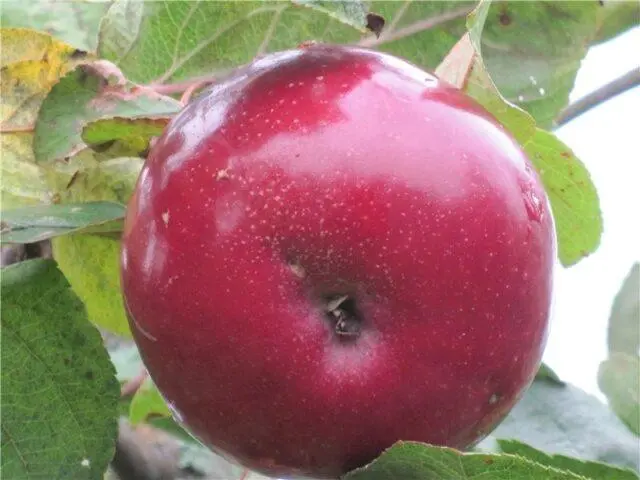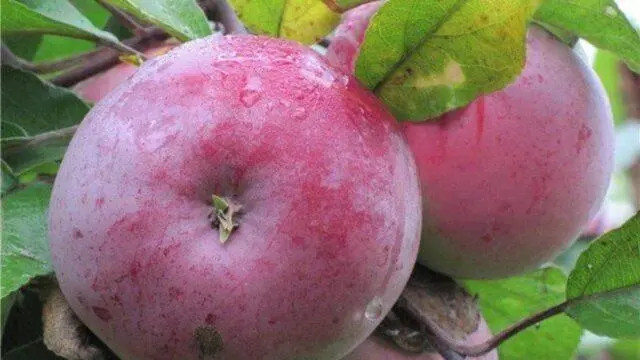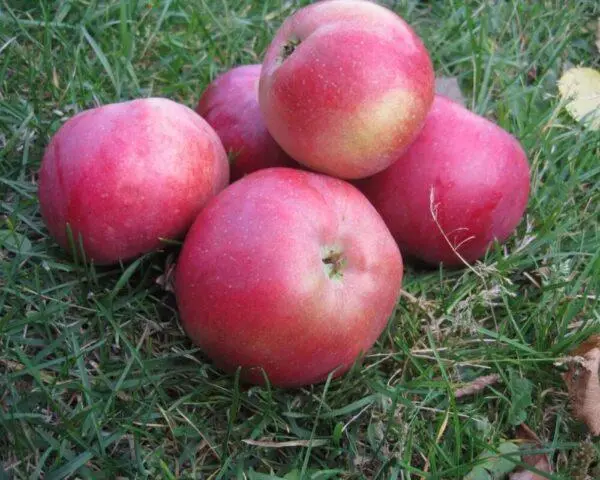Contents
Apple tree Belarusian Raspberry is one of the best varieties suitable for growing in the middle lane and northern regions. Gives attractive, fairly large fruits with a characteristic blush. Winter apples lie well until April.
History of occurrence
The Belarusian raspberry variety was bred in Belarus. The authors are Kovalenko G.K. and Kovalenko V. G. They took the Lavfam variety as a basis, and also used the popular variety Antonovka ordinary. The culture was included in the register of the Republic of Belarus in 1991.
It is not yet listed in the state register, but it is successfully grown in different regions, including in the middle lane. Recommend for cultivation in personal subsidiary plots. According to reviews, it takes root quite well even in the conditions of the Novgorod region.
Description of the apple tree Belarusian raspberry
The description of the variety contains the main characteristics of the tree and fruits. The most important parameters are presented below.
Crown
A tree of medium height, reaches 3-5 m. The crown is rounded, raised, shoot growth density is average. Skeletal branches are quite strong, grow straight. The surface is greyish brown. The main branches depart from the trunk by 40 degrees, but grow together very firmly.
The shoots of the apple-tree of the Belarusian raspberry variety are cranked, covered with a pubescent layer, painted in a rich burgundy shade. Dark cherry color. The lenticels are small, light in color, there are few of them. The leaves are large, rich dark green, leathery. The surface is glossy, shines in the sun. The shape is ovoid, symmetrical, the nose is twisted.
The leaf plates of the Belarusian raspberry apple tree are strongly bent along the central veins. At the same time, their edges are raised, wavy. Notches are noticeable, the teeth have a smoothed shape. The base of the plate is rounded. The petioles are small, rather thick, also burgundy in color. The kidneys are small, oval, pressed against the shoot. The crop ripens on twigs, and apples are also harvested from the rings. This feature should be taken into account when trimming.
Description of fruits
The fruits of the apple-tree of the Belarusian Raspberry variety are flat-round, less often just round, have a slight ribbing. The weight is average, mostly 100-150 g, some specimens reach 250 g. The funnels are narrow, shallow, rarely covered with rusty traces. The saucer is not too wide and shallow, has a slight folding.

Apples are bright red
The calyxes of the fruits of the apple-tree Belarusian raspberry are small, mostly closed. The subcup tubes are cone-shaped and connect to the hearts. The hearts themselves are small, resembling an onion in appearance, located in the upper region of the apple.
The seed chambers are small, the type is closed, the color of the seeds is rich brown. The stalks are short, no longer than funnels. They are quite powerful, at the point of attachment to the branches with a thickening. The peel of apples is smooth, thin and strong enough, does not crack.
In appearance, the fruits of the Belarusian Raspberry apple tree are attractive, they can be used for sale. A light green color prevails with a raspberry striped blurred blush covering a significant part of the surface. A wax coating is also noticeable, its shade is blue-gray. Subcutaneous points of a light shade, almost invisible, appear in small quantities.
Characteristic of the variety
Among the characteristics of the Belarusian raspberry apple variety, taste, ripening time and yield are of the greatest interest. The main parameters are described below.
Palatability
To taste, the fruits of the Belarusian raspberry apple tree are quite good. There is a balance of sour and sweet, as well as a fruity aroma. Tasting scores are consistently high and range from 4,0 to 4,2 points.
The pulp of Belarusian raspberry apples is quite juicy, on a cut of a white or cream shade, medium density, with a fine-grained texture. Pleasantly crunchy when biting. It contains (per 100 g):
- total sugar content over 10%
- acids about 0,5%;
- vitamin C – more than 18 mg per 100 g;
- P-active compounds – at least 270 mg per 100 g.
Terms of maturation
The fruiting of the Belarusian raspberry apple tree is early – it begins already 3-4 years after planting. In terms of ripening, the variety belongs to the late ones – the fruits are harvested from late September to mid-August. The culture is winter, the crop can be stored for several months until spring.

The fruits ripen by the beginning of October
Productivity
The crop yield is average. From one adult tree you can collect up to 40 kg. With the deterioration of the weather, the appearance of diseases and other adverse factors, the indicator may drop to 15-20 kg. Up to 200-300 centners are harvested from each hectare.
After 20-25 years, the indicator decreases – old trees are gradually replaced with new ones.
Frost resistance of apple-tree Belarusian raspberry
The apple tree variety is winter-hardy – it can withstand up to -30 degrees. Therefore, in most regions it can be grown without shelter. However, mulching is almost always required (except in the southern regions).
Pollinators
Apple-tree Belarusian raspberry is not self-pollinated. Therefore, to obtain a crop, it will be necessary to plant pollinators with the same flowering periods:
- Belarusian sweet;
- Minsk;
- Lovfam;
- Antonovka;
- Welsey.
Growing regions
Due to the high winter hardiness, the Belarusian Raspberry apple tree can be grown in different regions:
- middle lane;
- Northwest;
- the Volga region;
- Chernozem region;
- The Urals.
You can try to cultivate in Siberia, the Far East and the northern regions. But in these areas for the winter they definitely make a shelter.
Disease resistance
Belarusian raspberry is not resistant to fungal diseases and pests. Therefore, the tree needs annual preventive treatments to protect against various types of rot, rust, and powdery mildew.
Advantages and disadvantages
A variety of apple-tree Belarusian raspberry is valued for the good taste of fruits, their appearance and size, as well as for high winter hardiness. The culture is unpretentious, so even inexperienced gardeners can handle the cultivation.

Fruits are large, marketable
Pros:
- pleasant taste;
- large-fruited;
- good keeping quality and transportability;
- high winter hardiness;
- the crown is compact, so it does not take up much space;
- The taste of apples only improves with storage.
Cons:
- the variety is incapable of self-pollination – pollinators are needed;
- productivity is not very high;
- immunity to fungal diseases is average.
Planting an apple tree Belarusian raspberry
Seedlings are purchased from trusted nurseries. Landing is planned for spring (early April) or autumn (early October). The sequence of actions is as follows:
- Prepare the site (dig, fertilize).
- Mark several holes up to 80 cm deep, up to 100 cm in diameter with an interval of 4 m.
- Spread the roots of the seedlings and plant in the center.
- Sprinkle with soil so that the neck is 5-8 cm away.
- Tie to a pre-installed peg.
Next, the Belarusian raspberry apple tree seedling is watered and mulched with hay, sawdust, straw.
How to care
Caring for an apple tree is simple, it comes down to a few rules:
- watering twice a month;
- fertilizing 2-3 times per season (nitrogen compounds in the spring, during the formation of buds and flowering – superphosphate and potassium sulfate);
- loosening, weeding;
- mulching for the winter;
- regular spring pruning for sanitary purposes and for crown formation.
Collection and storage
Picking apples is planned for the end of September – the first half of October. The fruits should be harvested in dry weather without rain. They are sorted and stacked in wooden boxes and other containers.
You can store the fruits of the Belarusian raspberry apple tree at a temperature of about +5 degrees Celsius in a dark and humid place (up to 90%). Since the variety is winter, apples are stored until next spring. If the harvest is large, it can be used to make compotes, jams and preserves.

The fruits are storable, their taste improves during storage.
Conclusion
Apple-tree Belarusian raspberry is well acclimatized in different areas. The tree is unpretentious, but it needs pollinators. To ensure a stable yield, it is recommended to regularly water and fertilize, as well as to do preventive treatments for diseases.









